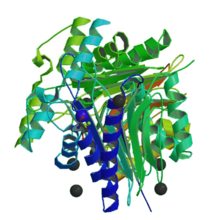Pharmaceutical compound
 | |
| Clinical data | |
|---|---|
| Pronunciation | /pəˈɡæspərɡeɪz/ |
| Trade names | Oncaspar |
| AHFS/Drugs.com | Monograph |
| MedlinePlus | a695031 |
| License data |
|
| Pregnancy category |
|
| Routes of administration | Intramuscular, intravenous |
| ATC code | |
| Legal status | |
| Legal status | |
| Identifiers | |
IUPAC name
| |
| CAS Number | |
| DrugBank | |
| ChemSpider |
|
| UNII | |
| KEGG | |
| ChEMBL | |
| Chemical and physical data | |
| Formula | C1377H2208N382O442S17 |
| Molar mass | 31732.06 g·mol |
| (what is this?) (verify) | |
Pegaspargase, sold under the brand name Oncaspar, is a medication used in the treatment of acute lymphoblastic leukemia (ALL). Often it is used together with anthracycline, vincristine, and corticosteroids (for example prednisone and dexamethasone). Pegaspargase can be administered either via an intravenous infusion or a intramuscular injection.
Known side effects include allergic reactions, coagulopathy, high blood sugar, affecting liver function, pancreas inflammation, and blood clots in the brain. There is no data regarding the usage of pegaspargase during pregnancy. Therefore, caution should be observed and pegaspargase should only be used during pregnancy when the benefits outweigh the possible risks.
Pegaspargase is a modified version of the enzyme asparaginase which has undergone PEGylation. It works by breaking down the amino acid asparagine that are circulating in the bloodstream. The circulating asparagine is essential for the cancer cells to enable growth since they can't produce their own, in contrast to normal cells. The normal cells are therefore less affected by pegaspargase.
Pegaspargase was approved for medical use in the United States in 1994. It is on the World Health Organization's List of Essential Medicines. It is made by Sigma-Tau.
References
- "Prescription medicines: registration of new chemical entities in Australia, 2017". Therapeutic Goods Administration (TGA). 21 June 2022. Retrieved 9 April 2023.
- "Prescription medicines and biologicals: TGA annual summary 2017". Therapeutic Goods Administration (TGA). 21 June 2022. Retrieved 31 March 2024.
- "Cancer therapies". Health Canada. 8 May 2018. Retrieved 13 April 2024.
- "Oncaspar EPAR". European Medicines Agency (EMA). Retrieved 21 January 2021.
- Graham ML (2003). "Pegaspargase: a review of clinical studies". Adv. Drug Deliv. Rev. 55 (10): 1293–302. doi:10.1016/S0169-409X(03)00110-8. PMID 14499708.
- ^ "Pegaspargase Monograph for Professionals". Drugs.com. Retrieved 11 October 2019.
- "Pegaspargase (Oncaspar) Use During Pregnancy". Drugs.com. Retrieved 11 October 2019.
- "UNM Cancer Center". Archived from the original on 3 September 2006. Retrieved 28 August 2007.
- "DailyMed - oncaspar- pegaspargase injection, solution for intramuscular and intravenous use". dailymed.nlm.nih.gov. Retrieved 25 September 2022.
- World Health Organization (2019). World Health Organization model list of essential medicines: 21st list 2019. Geneva: World Health Organization. hdl:10665/325771. WHO/MVP/EMP/IAU/2019.06. License: CC BY-NC-SA 3.0 IGO.
This antineoplastic or immunomodulatory drug article is a stub. You can help Misplaced Pages by expanding it. |